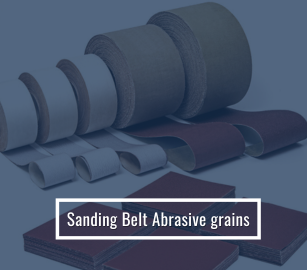
Sanding Belt Abrasive Grains

Abrasives were crucial for the metalworking industry since the Stone Age when bits of sand were used to grind, flatten, and smooth. For hundreds of years, animal skins were used for honing and sharpening knives and swords. Naturally available abrasives include emery, garnet, walnut shell, and even talc.
Today, most industrial abrasives began as a mineral ore that has been refined, hardened, and purified to optimize finishing characteristics.
Here we have mentioned all the sanding paper abrasives to make it easy for you to select the sanding belt for metal.
Types of Sanding Belt Abrasive Grains
Aluminum Oxide
It is a naturally occurring mineral refined during a refractory process to make a solid, harsh, and blocky shaped abrasive. Several alumina grades are made available through the refractory process, brown, pink, and white being the foremost common. The Aluminum Oxide Sandpaper is then further categorized as:
- White alumina is the purest; it's also the most rigid and most hard-wearing. White alumina cuts well in hard wearing metalworking applications and is employed in products like our JF4top material. JF4top is superb to be used on chrome steel finishing applications.
- Pink alumina may be a suitable general-purpose alumina abrasive and is employed in premium woodworking products like the KP947 paper comprehensive belt products.
- Brown alumina products would come with products like a bit softer and tends to be utilized in hand-held applications like our TF41' emery rolls.
Zirconium-Oxide Sanding Belt
Zirconia grain features a high heat resistance and is substantially stronger than alumina abrasives, making it an ethical choice for high-pressure grinding and machining applications. Zirconia belts, which work best within the 24 to 120 grit range, are regularly utilized in steel fabrication shops.
Although more challenging than alumina, zirconia may have difficulties grinding mill scale, they still do a high-quality grinding job on:
- Stainless steel
- Tool Steel
- Nickel Alloy
- Aluminum
- Titanium
- Cast Iron
- Carbon Steel
- Blades, Rotors, and Welds
Zirconia requires more pressure to sand. Therefore the belts are better-suited for jobs on more challenging surfaces and not ideal for polishing.
It is significantly more stringent than pink and brown alumina abrasives, making zirconia grain compatible with high machining and grinding applications. Zirconia grain also features good heat resistance. Zirconia abrasives work best within the grit range of 24 to 120 grit.
Zirconia abrasives are commonly utilized in general steel fabrication shops to become the abrasive belt and disc of choice for the grinding and finishing of steel. They're also widely used in chrome steel applications; however, many new ceramic abrasive products supplied by AFS are revolutionizing metal grinding applications.
Ceramic Sanding Belts
Ceramic sanding belts are making a significant impact on the standard and efficiency of metal grinding applications. they're very fashionable within the knife industry for finishing high steel. Ceramic abrasives provide the most extended life and fastest bargain rate out of the other sort of abrasive grain.
The structure of the Ceramic Sandpaper is more uniform than zirconia, and their micro-crystalline habit enables them to interrupt down during a more controlled manner and be utilized in a broader range of applications, including:
- Aluminum Castings
- Stainless Steel Finishing
- Titanium Alloys (commonly utilized in aerospace applications)
- Mild Steel Mill Scale
The micro-grain structure of sanding belts leads to smaller fragments being broken away during the grinding process, which provides them an extended performance life than their zirconia counterparts. However, unlike zirconia, ceramic is particularly sensitive to pressure and warmth, so their use in such applications must be carefully engineered.
Ceramic abrasives have a micro-crystalline habit and are more uniform in their structure than either alumina or zirconia abrasives. This habit means ceramic grains break down in a controlled manner extending the range of available applications.
However, it is essential to notice that ceramic abrasives are particularly sensitive to heat and pressure, suggesting 1x30 belt sander that a correctly engineered process is vital to their successful use.
Silicon Carbide Sanding Belt
The natural mineral sort of carbide is long, thin, and sharp, so when brooding about carbide abrasives, consider a belt or disc covered in thousands of small but very sharp knives.
So why are carbide abrasives not used everywhere? Because although they'll be very sharp, they're also more brittle than other abrasive grits, suggesting that they break down more quickly.
All this suggests that carbide abrasives are excellent once you need a clean, bright cut or for curtailing lacquers or polishing stone, but not very useful under high grinding applications.



































































